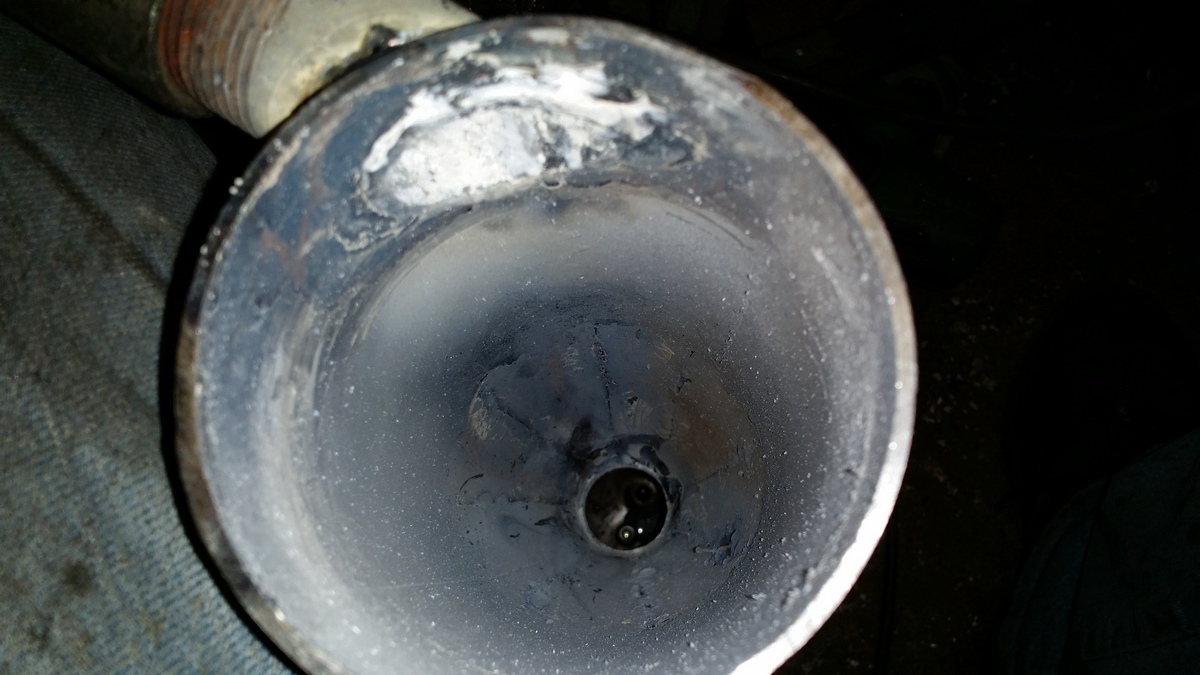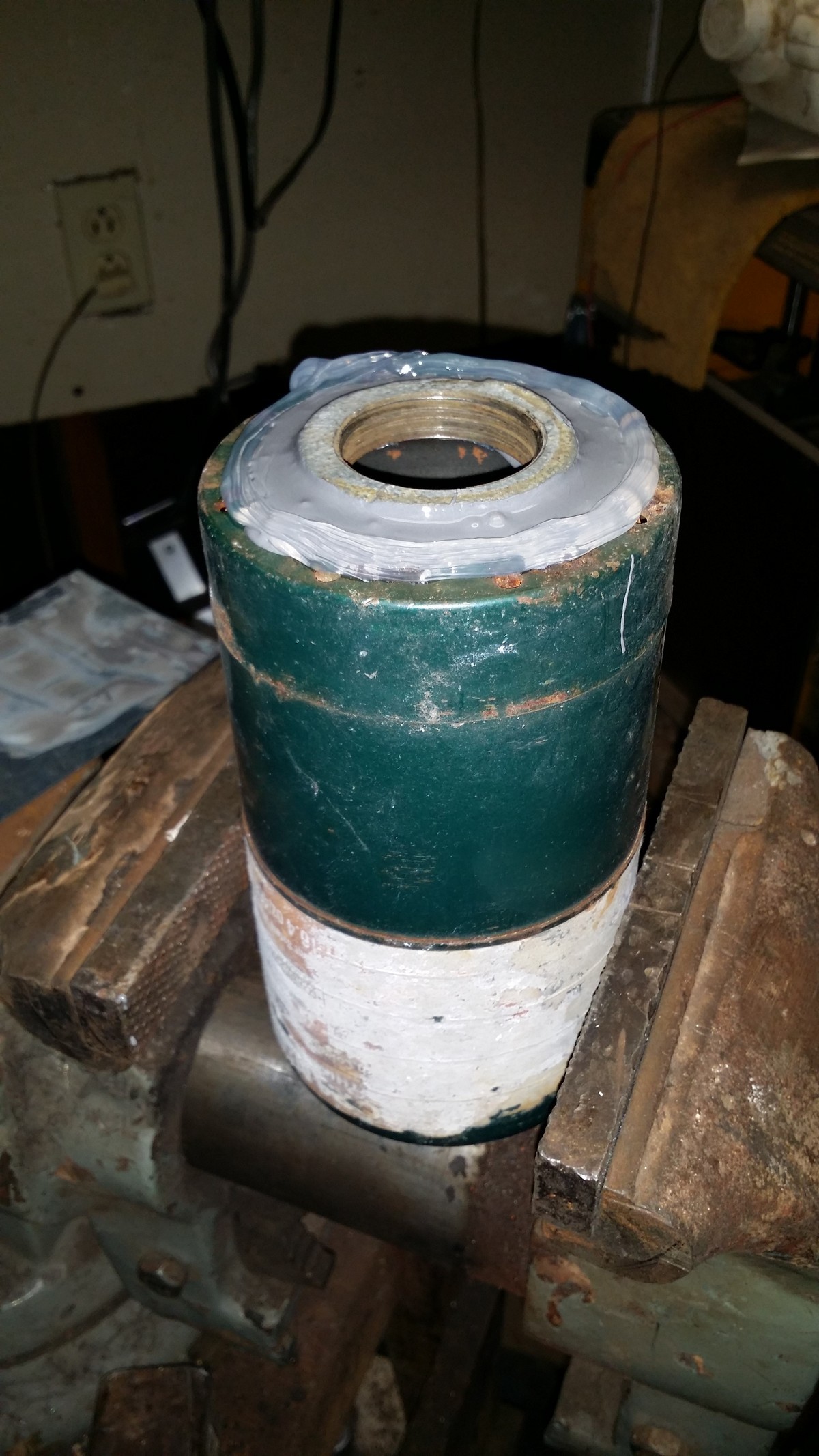cyclone filters are good to remove heavy dust from any gas stream. I have used them in wood working for many years for dust control. They are now mostly obsolete and have been replaced with bag houses. Like any filter cyclones do not work well with tar or high moisture, they can plug up.
Hi Dave,
There are established principles of cyclone design, and frankly that one pictured doesn’t look proportional to me. Check the Handbook of Biomass Gasifier Systems for some great examples of cyclones and sizing. They can certainly be used in wet conditions. Tar is too sticky, but there should never be tar coming out in finished gas anyway, only ever out of the hopper condensate.
Your right the drop tube was way to long. I edited the pic and this will work OK.
Thanks for pointing out my error
Dave
Hi Chris, Usually my cyclone is between 300 and 400 F at the outlet in the center of the pipe when things get rolling. It rarely gets water in it but it is pretty impressive how much ash and soot it will accumulate in even 20 miles. I rarely have to wash my coolers out with a real cycIone in line. I hope to get to Argos early afternoon and will remove the jar then … It’s about 350 miles there and I figure to do around half of that on wood. With all the crap I’m hauling I will only be able to load up around 10 or 12 of my sacks. I usually use 50 pound onion sacks and slip them in feed bags to keep the rain off and moisture down. Most of the trips I have been on have been raining one way or the other. I will be driving around a GREAT lake to get there.
I don’t know when I originally drew this and I don’t recall if I posted it before but here goes
http://www.intergate.com/~mlarosa/images/woodgas/cyclone020710.pdf
I just downloaded it from the yahoo site and uploaded it to mine. DJ supplied the initial dimensions. I think they were for a 5 liter motor. I built mine out of a single 2’ piece of heavy gauge, 6" stove pipe but it is now rusting through but it does have many thousands of miles on it …
… Mike
oops, This was DJ’s calcs for a 7 liter engine … Thanks DJ !! It’s been working great …
http://www.intergate.com/~mlarosa/images/woodgas/cyclone1.pdf
Mike
I’ts hard to imagine all that gas going through a 2.7" exit pipe. When I scale it down for my 2.5L It becomes a 1.6" pipe with a 3.25" diameter body!!
Terry G, I have been trying hard to find a Chevy S-10 or the such with a 2.2 liter to put one of my double rotor units on. They usually go to Mexico when traded in and are tough to find. I will still go with the larger (3" +/-) piping but realize I can restrict it in a few spots like at the cyclone to force the spin rate up. I have a 97 Cavalier here with a 2.2 and have already put a trailer hitch on it and have pulled the trailer around with it but I haven’t cut the holes yet to run the gas piping and of course am just trying to survive so it won’t be in Argos. You will get to see the same old truck again if it makes it (hopefully) but it will be running on the trailer. I’m hoping that my trailer can get hooked into some of the other folks machines so I / we can compare gas output and power. I will be bringing enough stuff so this can possibly happen. Duct tape of course. Mike
Hi Dave,
I guess I should do more reading. I just found the answer to one of my questions on your vid post, the cyclone (tapered sides) and the preheat shroud. Yours is an easier fit than the fins and shroud that I had in mind. Now to find that just right size container.
Pepe
Hi David, I don’t know if you are still thinking about cyclones because this thread is a little old but I made a cyclone last week for my charcoal lawn tractor. I am sure others have done it like this before but this was quick and simple. I took a 3-1/2 inch thinwall pipe and cut 8 wedges out of it after calculating how much metal to leave on each remaining bottom section to fit a 1-1/4 inch thread connection.
Then clamp it together after tapping the edges flush.
A look down the inside shows a pretty smooth cone after it is welded.
I sawed a 1-1/4 inch close nipple in half and welded it to the bottom
JB Weld holds a female thread connection sawed off a pipe fitting on to the bottom of a short fat propane cylinder and a bead of silicone holds the JB in place until hard.
This post from al frick’s build seems to discourage cooling in the cyclone. http://forum.driveonwood.com/t/al-fricks-2000-dakota-4-7/1168/16?u=handy_andy
Then again others have done it before.
Andy, wood burning gasifiers have a lot of moisture in the gas. Most of this moisture is cooked out in the charcoal making process so I don’t expect it to be a problem. I have been meaning to ask Gary Gilmore and David Bailey about moisture in a charcoal system.
Don,
I have moisture in my charcoal gas. 
Been using old charcoal so I’m sure it has absorbed moisture. A lot gets condensed out.
Jeff
Andy,
Cooling in the cyclone is great as long as you stay above the dew point. Once the dust is clumpy it builds up on surfaces and clogs the exit.
Stephen
Thanks Jeff,
Does the water condense out in the pipes that go around your unit before it gets to the filter?
Hi Don,
Most of it condenses in the cooling pipe. Some in the cyclone which hasn’t been a problem and some in the final filter. The cyclone and water filter (final) is new for this year.
Jeff
Hmmm.
Well this last exchange bit says why that I personally do not any longer use cyclone filtering.
Of course they work. And work best on a gasifer raw wood or charcoal gasifier if properly sized for the internal spin/velosity range needed and size of the particles being removed.
Versus large aspect ratio sawdust cyclones and grain dust cyclones the gasifier ones need to be very small diameter, longish and “too small” looking.
Dutch John, John Blount, StephenA from the get-go; and BenP’s and APL/Jim Masons later works are all wood ash/soots sized optimal. DonM. your new one looking good too.
I just easy changed over to settlement/riffle horizontal chambers as a stationary guy not caring about size and weight.
To me a cyclone separator, or settlement chamber are both just coarse pre-filtering to always be kept safely above any running conditions condensation point.
Then later; at an in-line fine filter also a condensation point choice must be made.
Some preferring to keep this heated as a dry bag/sock house assembly.
Others choosing to use an intentionally cooled raining wet washing gas system.
Done both of these too. Too hard to keep the dry, hot and dry and not burn up IMHO.
The wet washer added another electric motor in the pump and created a difficult wet slurry disposal problem. Freeze headache for those with that problem.
For the widest range of conditions flexibility of usage just use a nominally dry-ish to conditions condensate wetted capable fine filtering system. Open cell foam. Layered sheep’s wool fabrics. “Hay”/straw. Whatever is available. Replace out and open air burn. Or wash’n dry reuse.
Ha! But then remember, I’m the guy intentionally using carbons/soots as an IC piston engine fuel.
Regards
Steve Unruh
Hi Steve,
This spring I replaced my Walmart sock filter with a cyclone. I do see some fine ash clinging to the half of an inverted water bottle and I’ll wipe the inside of the nut jar with a white rag to see if it collected some soot later when I have the time. Might work a bit better now that I cut it in half. To be honest I might be happier with the sock filter before my final filter but I’m sure my cyclone is lacking in design.
Jeff
Jeff, I don’t remember reading about the walmart sock filter. Do you have a build thread here?
Btw, You still have the red diamond 450? and where are you located?
Andy
Before I installed my new cyclone filter on my charcoal gasifier I temporarily hooked it up to a small vacuum and sucked some dust off my shop floor in a small area around the chair I was sitting in. I was surprised to find that it was almost 1/8th full of dust when I unscrewed the canister. ( maybe I should clean more often)  I started to try to calculate my engine velocity compared to the vacuum but I gave up. I am not a good numbers man like Steve A is.
I started to try to calculate my engine velocity compared to the vacuum but I gave up. I am not a good numbers man like Steve A is.
If the cyclone cools too much down to the dew point, maybe insulating the top half or top one quarter might keep it from condensing?





